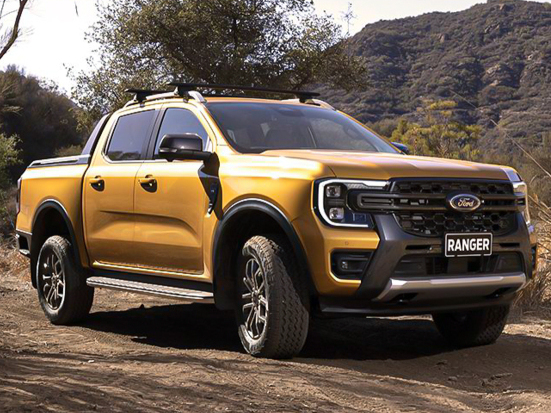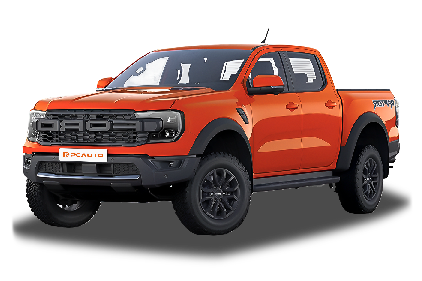Q
How much horsepower does the Raptor 3.0 V6 have?
The Ford Raptor's 3.0-liter V6 twin-turbo engine, as offered in the Malaysian market, cranks out a robust 450 horsepower and a peak torque of 691 Nm. This high-performance powerplant is engineered specifically for tackling tough terrain and high-speed off-roading. Paired with a 10-speed automatic transmission and 4WD system, it handles Malaysia's diverse road conditions with ease.
What's notable about the Raptor, being a high-performance pickup, is that its power delivery isn't just about raw burst; the turbocharging tech and advanced cooling system ensure stable performance even under prolonged heavy loads. You see similar engine tech in other high-performance off-roaders too – some German SUVs, for instance, use comparable turbo setups to balance power and fuel efficiency.
For Malaysian buyers who often do long highway drives or need to haul heavy loads, the low-end torque of these large-displacement turbos is a real plus. They hit max torque around 2000 rpm, making overtaking or climbing hills feel effortless. Just keep in mind these performance machines need RON95 or higher fuel locally to run at their best, and regular turbo system maintenance is a must.
Special Disclaimer: This content is published by users and does not represent the views or position of PCauto.
Related Q&A
Q
Does the Ford Ranger Raptor 3.0 have a wet belt?
Under the hood of the Ford Ranger Raptor 3.0 lies a 3.0-liter V6 EcoBoost twin-turbo gasoline engine, and here's a key detail that matters: it uses a timing chain instead of a wet belt. Timing chains are known for their longer lifespan and enhanced reliability; unlike wet belts, they typically don't require regular replacement. It's a common setup in many high-performance engines, and for good reason.
For Malaysian users, this timing chain design is a smart fit. It's better suited to the region's variable climate conditions and off-road demands, cutting down on both maintenance frequency and costs. Wet belts, which you often find in some European engine designs, need to be swapped out at specific mileage or time intervals – skip that, and you could be looking at serious engine damage. The Ranger Raptor 3.0 avoids that headache entirely with its timing chain, letting owners focus on what really matters: unleashing that beastly 406 horsepower and 583 Nm of torque for some epic off-road adventures.
Plus, Ford backs this engine with comprehensive warranty coverage, adding extra peace of mind to the ownership experience. Just remember to stick to the official recommended maintenance schedule to keep that engine running in peak condition.
Q
What is the top speed of a Ranger Raptor?
The Ford Ranger Raptor, as a high-performance pickup, has an officially stated top speed of 190 km/h. That figure comes courtesy of its 3.0-liter V6 EcoBoost twin-turbo engine, which cranks out a healthy 392 horsepower and a robust 583 Nm of torque. Paired with a 10-speed automatic transmission and four-wheel drive system, it ensures stability and power delivery even when pushing the pace.
In the Malaysian market, the Ranger Raptor's top speed is more than enough to handle most driving scenarios, whether you're cruising down the highway or tackling off-road trails. Its suspension setup is specially tuned too, featuring FOX shocks and a reinforced chassis, so it balances high-speed capability with off-road toughness surprisingly well.
It's worth remembering, though, that top speed isn't the be-all and end-all of a vehicle's performance. The Ranger Raptor really shines when you look at the overall driving experience – things like that meaty low-end torque and its ability to crawl out of tricky off-road situations. Those are the traits that make it so practical here in Malaysia, with our diverse range of terrains.
And hey, while we're on the topic of speed, a quick reminder for owners: always stick to the local speed limits when you're out and about. Safety first, right?
Q
Does the Ranger Raptor have a heated steering wheel?
The Ford Ranger Raptor currently on sale in the Malaysian market doesn’t come standard with a heated steering wheel. This high-performance pickup prioritizes off-road capability and driving dynamics, with its key features focused on professional off-road gear like the Terrain Management System, FOX Performance shock absorbers, and the Baja drive mode. It’s worth noting, though, that specifications can vary between model years and regions, so interested buyers should check directly with authorized Ford dealers in Malaysia for the latest equipment details.
Speaking of heated steering wheels, they’re a pretty handy comfort feature in colder climates. The built-in heating elements warm up the wheel quickly, making it much more pleasant to grip when temperatures drop. Now, Malaysia being a tropical country with consistently high temperatures, this feature might not get much use day-to-day. Even so, some premium models still include it as part of their luxury offerings. If you’ve got a specific thing for these comfort extras, it’s worth asking your dealer if a post-purchase installation is possible. Just make sure to go through official channels to keep things safe and protect your warranty coverage.
Q
What engine is in Ranger Raptor?
Under the hood of the Ford Ranger Raptor lies a 2.0-liter four-cylinder twin-turbo EcoBlue diesel engine, cranking out 213 horsepower and a meaty 500 Nm of peak torque. Mated to a 10-speed automatic gearbox, this powertrain isn't just about brute low-end grunt – though it's got plenty for off-roading – it also delivers a smooth ride when you're cruising the highway.
But the Raptor's party piece doesn't stop there. It's kitted out with an advanced 4WD system and a range of drive modes: Normal, Sport, Off-Road, and even a Desert mode, letting drivers tweak the truck's character to tackle just about any terrain thrown its way. What's really impressive is how this relatively small-displacement engine, thanks to those twin turbos, punches way above its weight, serving up power that feels right up there with bigger engines, all while being easier on fuel.
For Malaysian buyers, that balance of performance and efficiency is a big win, perfectly suited to the country's diverse road conditions and driving needs. All in all, the Ranger Raptor's powertrain setup makes it a serious contender in the performance pickup segment, and a solid showcase of Ford's engineering chops when it comes to off-road-ready vehicles.
Q
Do Ford Raptors hold their value?
The Ford Raptor series holds its value pretty well in Malaysia's used car market, and that's mainly down to its beastly off-road capabilities, unique pickup positioning, and the fact that it's a relatively rare imported ride. Under the hood, you've got that high-performance EcoBoost engine, paired with pro-level gear like the FOX suspension system – stuff that keeps demand steady among off-road enthusiasts. Plus, Ford's solid reputation in the pickup game doesn't hurt when it comes to retaining residual value.
Compared to your average family car, these performance-focused pickups tend to depreciate slower. Why? Their audience is niche, and there's not much direct competition out there. And if the truck's in good shape with a full service history? Even better – those are the ones used car buyers really go for.
But here's the thing: used car prices in Malaysia aren't just about the vehicle itself. Import tax policies, fuel subsidy changes, and market trends all play a part. For example, if the government starts pushing new energy vehicles harder, that could take some shine off big-displacement models like the Raptor indirectly.
If you're looking to buy, my tip is to check historical transaction prices on local platforms like Carlist or Mudah. Also, keep an eye on whether the truck still has its original factory warranty – that helps you gauge the resale value retention more accurately. And if you plan to hold onto it long-term? Stick with classic colorways like the iconic "Code Orange" or keep those original parts intact – both smart moves to help maintain that resale value down the line.
Q
Is the Raptor engine reliable?
The EcoBoost engine under the hood of the Ford Raptor has a solid reputation for reliability. This 3.5-liter V6 twin-turbo unit has stood the test of time in the market, proving its durability especially when pushed hard off-road or under heavy loads. Ford's engineers really put in the work with the high-strength aluminum block, twin-turbo setup, and direct injection system—all tuned specifically to handle the demands of spirited driving.
Now, here's the thing for folks in Malaysia: that tropical climate means you’ve got to stay on top of maintenance. High temperatures and humidity can speed up the aging of rubber hoses and seals, so regular changes of high-quality coolant and engine oil are non-negotiable.
On the flip side, the 10-speed automatic transmission pairs with the engine like a well-oiled machine—they’ve clearly had plenty of time to dial in that partnership. But, as with any high-performance rig, sticking to Ford’s recommended service intervals and using factory-spec fluids isn’t just a suggestion, it’s a must.
For Malaysian drivers who regularly take their Raptor off-road or haul heavy loads, don’t sleep on checking the undercarriage—suspension components and the drivetrain need extra love to keep performing at their best. Remember, these trucks are built to handle tough conditions, but they’ll only keep delivering if you treat them right with proper care.
Q
Does Ranger Raptor have full time 4WD?
Regarding whether the Ranger Raptor comes with a full - time 4WD system, this high - performance pickup actually uses a part - time 4WD setup instead. Its system offers three modes: 2H (rear - wheel drive), 4H (high - range 4WD), and 4L (low - range 4WD), which you switch manually via a rotary dial to suit different road conditions. This design allows for more precise power distribution when off - roading, while also helping keep fuel consumption in check. It’s worth noting that both full - time and part - time 4WD have their pros. Full - time 4WD is great for all - weather highway driving but tends to guzzle more fuel. Part - time 4WD, on the other hand, prioritizes mechanical reliability when hitting the trails. Malaysian buyers should pick based on their needs – if they’re often tackling rainforests or muddy tracks, the Ranger Raptor’s part - time 4WD paired with an electronic differential lock already delivers serious off - road capability. For city use though, switching to 2H will reduce fuel consumption. Also, with Malaysia’s rainy climate, even in rear - wheel drive mode, ensure the ESP system is activated to keep you safe on slippery roads. And don’t forget to regularly check the fluid levels in the drivetrain components to keep that 4WD system performing at its best.
Q
Can you tune a Ranger Raptor?
Sure thing. As a high - performance pickup, the Ranger Raptor can definitely achieve a significant improvement in power and driving experience through tuning. Here in Malaysia, plenty of professional tuning shops offer services specifically for this truck, like ECU remapping, exhaust system upgrades, and suspension tweaks. By adjusting parameters such as fuel injection and turbo boost pressure, you can significantly increase the horsepower and torque. Pair that with improved intake and exhaust systems, and the truck handles high - load situations much more consistently. Also, with Malaysia's tropical heat, engine cooling is of great importance. So any reliable tuning job around here will also focus on optimizing the cooling system to ensure reliability even when you're driving it aggressively for extended periods. However, a word of caution: while tuning unlocks more performance, going overboard can void your factory warranty or make your ride fail local emissions regulations. It is advisable to choose reputable and certified tuning shops and use compliant setups to keep everything safe and legitimate. For owners who are interested, diving into Malaysia's popular car culture scenes—like off - road modifications or track day setups—can really help the Ranger Raptor reach its full potential.
Q
Is the Ford 6.2 Raptor a good engine?
Ford's 6.2 - liter V8 engine, the power core of early Raptor models, indeed exhibits a distinctive American - style performance. Its big - displacement naturally aspirated design provides that satisfying low - end torque punch (434 hp/588 Nm), making it a solid fit for Malaysia's rainforest terrain. Whether you're slogging through mud or crawling up steep inclines, it provides that smooth, linear power delivery you need off - road. The cast - iron block also enhances durability, which counts for a lot when the going gets tough. Now, let's talk reality, this engine isn't exactly a fuel sipper. With a combined fuel consumption around 15L/100km, it's not the most eco - friendly option out there, especially with Malaysia's recent push for more energy - efficient policies. If you're being cost - conscious, the concurrent 3.5 - liter EcoBoost twin - turbo definitely has the edge when it comes to taxes and daily running costs. But here's the thing – if you're chasing that raw mechanical reliability and love the idea of modifying your ride, the 6.2 - liter still holds a special place for die - hard off - road enthusiasts. My advice? Potential buyers really need to weigh their actual usage. If you're regularly tackling long overland trips and fuel costs aren't a major concern, this engine's got two big things going for it in Malaysia: easy maintenance and a healthy supply of aftermarket parts in the third - party repair scene. Those are real - world perks that shouldn't be overlooked.
Q
When did Ford stop putting V8 in Raptor?
Back in 2017, Ford made the call to drop the V8 engine from the F-150 Raptor, swapping it out for the more efficient 3.5-liter EcoBoost V6 twin-turbo setup. The main driver behind this shift? Keeping that high-performance edge while squeezing out better fuel economy and trimming emissions – all to keep up with the global auto industry's ever-tightening focus on green tech and efficiency.
For Malaysian truck fans, sure, the deep, throaty rumble and classic appeal of that V8 are definitely missed. But let's be real – the EcoBoost V6 doesn't slouch in the power department. In fact, it even edges ahead in some areas, like low-end torque and turbo response. Plus, it's a better fit for Malaysia's road conditions and fuel quality.
And Ford isn't alone in this tech pivot. A lot of brands are gradually moving away from big-displacement engines, instead doubling down on developing more efficient small-displacement turbos or hybrid systems. It's just the way the industry's heading these days.
If you're into Raptors or other high-performance pickups, keep an eye on your local dealers. Every now and then, the Malaysian market does get some special edition models brought in.
Popular Cars
Model Year
Car Compare
Car Photo
Latest Q&A
Q
What does engine capacity refer to?
Engine Capacity refers to the total volume of all cylinders inside the engine, usually expressed in cubic centimeters (cc) or liters (L), such as 1.5L or 1500cc, It directly reflects the total amount of air and fuel mixture that the engine can inhale and compress in a complete cycle. A larger engine capacity usually means higher power output because more fuel and air participate in combustion, producing stronger explosive force to push the piston. However, engine capacity is not the only factor determining performance. Turbocharging, fuel injection technology, etc. can also allow small displacement engines to perform close to or even better than large displacement engines. In addition, engine capacity also affects fuel consumption and road taxes. Although large displacement engines have abundant power, their fuel consumption is relatively high, and they may need to pay higher annual road taxes, while small displacement engines are more economical and suitable for daily commuting. When choosing a vehicle, You can balance the relationship between engine capacity and fuel economy according to your driving needs.
Q
How do I find engine capacity?
To find your vehicle's engine capacity, the easiest ways are to check the owner's manual or the engine bay sticker – you'll usually see it clearly marked as something like 1.5L or 2.0T. Another option is to look at your vehicle registration card (Geran) or check the JPJ website for detailed specs, where the engine size will be listed.
Engine capacity is measured in liters (L) or cubic centimeters (cc), with 1.0L equaling 1000cc. It tells you the total volume of all cylinders and gives a rough idea of power and fuel efficiency. Generally, bigger engines deliver more power but may drink more fuel.
That said, performance isn't just about size – tech like turbocharging and fuel injection also plays a big role. If you're mainly commuting, a smaller engine could be the smarter pick, while drivers who want more punch might prefer a larger or turbocharged setup.
Still unsure? Your best bet is to call an authorized service center for the exact specs.
Q
How many cc is a 1.2 litre engine?
A 1.2L engine has a displacement of 1,200cc—since one liter equals 1,000 cubic centimeters (cc), simple math does the trick. Engine displacement measures the total swept volume of all cylinders, serving as a key indicator of power output. Generally, bigger displacement means more muscle, though at the cost of higher fuel consumption.
In our market, 1.2L engines are commonly found in budget-friendly compact cars, striking a solid balance between fuel efficiency and adequate pep for city driving. But here’s the catch: While displacement matters, real-world performance hinges on engineering tricks like turbocharging or direct injection—tech that can squeeze extra power from small engines while keeping thirst for fuel in check.
If fuel economy tops your checklist, a 1.2L powertrain deserves a look—just don’t skip the test drive. Numbers tell part of the story; how it *feels* on the road tells the rest.
Q
How many cc is a V8 engine?
The displacement (cc) of a V8 engine isn't a fixed number—it varies based on the vehicle model and manufacturer's design. Typically, you'll find them ranging between 4.0L and 6.2L, which translates to roughly 4000cc to 6200cc. Classic American muscle cars, for example, often pack a 6.2L (6200cc) V8, while some high-performance sports cars or luxury models might use a smaller 4.0L (4000cc) turbocharged V8.
Thanks to its symmetrical eight-cylinder layout, a V8 delivers both raw power and smooth acceleration, making it a favorite for drivers who crave performance or that big-displacement thrill. But remember, displacement isn't the only factor in power output. Modern tech like turbocharging, direct injection, and variable valve timing can squeeze out more efficiency and horsepower from even a smaller V8.
With tighter emissions regulations, many automakers are now exploring hybrid systems or downsized V8s to balance performance and eco-friendliness. Going forward, V8 development will likely focus more on tech upgrades than just upping displacement.
Q
What is the best engine capacity?
Choosing the right engine displacement depends on your personal needs and driving habits. Generally, a 1.5L to 2.0L engine strikes a good balance between power, fuel efficiency, and maintenance costs—making it ideal for daily commutes and family use. These engines are tried-and-true, easy to service, and relatively economical on fuel.
If you frequently take long trips or crave stronger performance, engines above 2.0L deliver better acceleration and highway stability, though at the cost of higher fuel consumption and road tax. Meanwhile, small turbocharged engines (like 1.0L or 1.2L turbos) have gained popularity in recent years. They offer near-equal punch to larger engines while sipping less fuel and keeping tax bills low—perfect for city driving or budget-conscious buyers.
Hybrids and EVs, on the other hand, sidestep traditional displacement concerns altogether, relying on electric motors for efficiency. As tech evolves, raw displacement may matter less than overall energy effectiveness in the long run.
View MoreRelated News

Ford Focus is about to cease production in November and may return in 2027 in the form of an SUV.
WilliamSep 15, 2025

2025 Ford Ranger WildTrak launched, the most powerful diesel version in the Ranger lineup
MichaelAug 25, 2025

Is the Ford Ranger V6 about to enter Malaysia?
LienAug 13, 2025

Reviewing the Ford Ranger: The Dual Advantages of Rugged Appearance and Powerful Performance
Kevin WongApr 21, 2025

Ford Unveils “Simulated Manual Transmission” Patent to Reignite Driving Pleasure in Electric Vehicle
LienApr 2, 2025
View More


















Pros
Cons